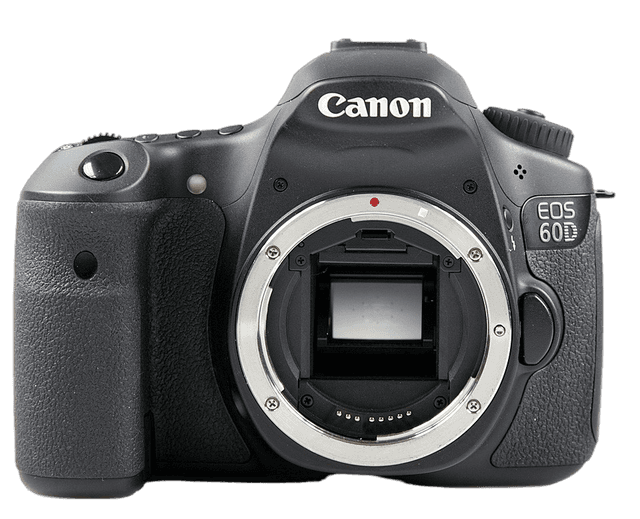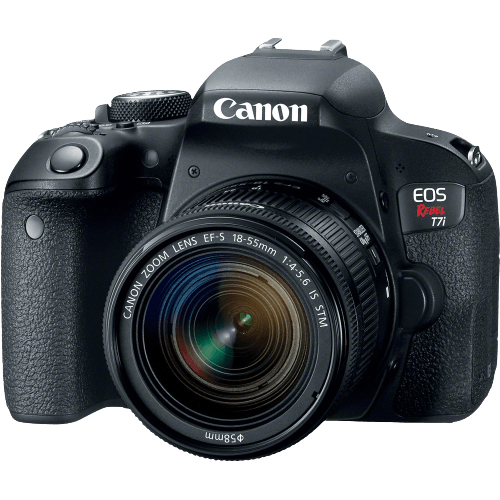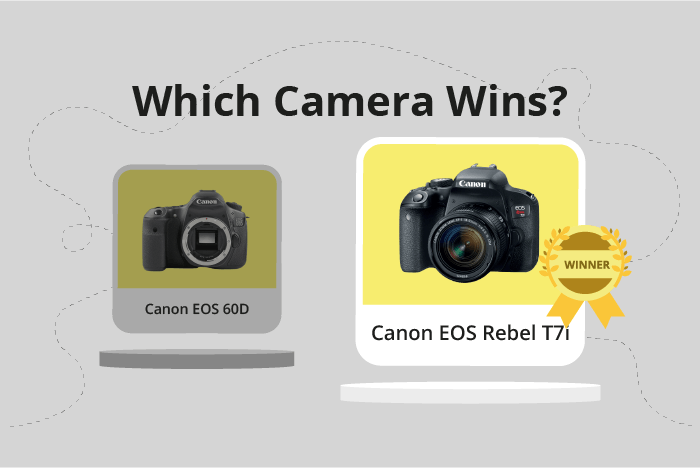Canon EOS 60D vs EOS Rebel T7i / 800D Comparison
Canon EOS 60D

Canon EOS Rebel T7i / 800D

The Canon EOS Rebel T7i (800D) outperforms the Canon EOS 60D with a score of 64/100 compared to 47/100. Both are DSLR cameras, released in 2017 and 2010 respectively, with the T7i being more affordable at $779 compared to the 60D’s launch price of $1199.
The cameras share design similarities in size, with the T7i being slightly smaller (131 x 100 x 76mm) and significantly lighter (532g) than the 60D (145 x 106 x 79mm, 755g). This makes the T7i more portable and easier to handle during extended shooting sessions.
The T7i’s higher score reflects its better performance in terms of image quality, autofocus, and other modern features. However, the 60D has its advantages, such as a more robust build and a longer battery life. It’s crucial for potential buyers to weigh these factors based on their specific needs and preferences.
Ultimately, the Canon EOS Rebel T7i (800D) is the superior choice for most photographers due to its better performance, affordability, and compact design, while the Canon EOS 60D may still appeal to those who prioritize build quality and battery life.
Canon EOS 60D vs EOS Rebel T7i / 800D Overview and Optics
The Canon EOS Rebel T7i/800D outperforms the Canon EOS 60D in optics, scoring 64/100 compared to the 60D’s 43/100. This 21-point difference reveals the T7i/800D’s superiority in this aspect.
Both cameras share several common specifications, including the CMOS sensor type, APS-C sensor size, Canon lens mount compatibility, and lack of image stabilization. Despite these similarities, the T7i/800D surpasses the 60D in several key areas.
The T7i/800D has a higher megapixel count at 24 compared to the 60D’s 18, which results in more detailed and sharper images. Its shooting speed is also faster at 6 frames per second (fps) compared to the 60D’s 5.3 fps, allowing for better capture of fast-paced action. The T7i/800D also benefits from a more advanced Digic 7 processor, which enhances image quality and processing speed. Additionally, the T7i/800D has a higher DXOMARK score for the sensor at 79, indicating better overall performance and image quality.
The 60D, however, does not have any areas in which it performs better than the T7i/800D in terms of optics. Its lower megapixel count, slower shooting speed, and lower DXOMARK score confirm its inferiority in this comparison.
Considering each point, it is evident that the Canon EOS Rebel T7i/800D is the superior camera in terms of optics. Its higher megapixel count, faster shooting speed, more advanced processor, and better sensor performance contribute to its higher score and better image quality. The 60D, on the other hand, falls short in these areas and does not offer any advantages over the T7i/800D.
Canon EOS 60D vs EOS Rebel T7i / 800D Video Performance
The Canon EOS Rebel T7i / 800D emerges as the winner in the video capabilities comparison, with a video score of 70/100, while the Canon EOS 60D trails behind at 43/100. Both cameras share some common specifications in video recording: they both have a maximum video resolution of Full HD and maximum video dimensions of 1920 x 1080 pixels.
The Rebel T7i / 800D outperforms the 60D in a few key areas. First, it boasts a higher maximum video frame rate of 60fps, allowing for smoother and more detailed motion capture compared to the 60D’s 30fps. Additionally, the T7i / 800D has a built-in time-lapse functionality, enabling users to create stunning time-lapse videos without the need for external accessories or software.
On the other hand, the 60D does not offer any significant advantages in video capabilities over the T7i / 800D. Its lower video score reflects its limitations in frame rate and the absence of time-lapse functionality.
Considering the differences in video performance, the Canon EOS Rebel T7i / 800D is the better choice for those prioritizing video capabilities. Its higher frame rate and built-in time-lapse feature make it more versatile and suitable for a broader range of video applications. Meanwhile, the Canon EOS 60D falls short in providing a competitive video experience, making it a less attractive option for videographers and content creators.
Canon EOS 60D vs EOS Rebel T7i / 800D Features and Benefits
The Canon EOS Rebel T7i / 800D emerges as the winner in terms of features, with a score of 70/100, while the Canon EOS 60D scores 57/100. Both cameras share several specifications, such as a 3-inch screen size and a screen resolution of 1,040,000 dots. Additionally, both cameras possess flip screens, providing flexibility for various shooting angles.
The Canon EOS Rebel T7i / 800D outperforms the EOS 60D in several aspects. It offers a touchscreen, making it easier to navigate menus and change settings. Furthermore, the T7i / 800D has GPS, enabling geotagging and location tracking for photos. The camera also includes Wi-Fi and Bluetooth capabilities, allowing for seamless sharing of images and remote control functionality.
On the other hand, the Canon EOS 60D does not have any specific advantages over the T7i / 800D in terms of features. It lacks a touchscreen, GPS, Wi-Fi, and Bluetooth, making it less convenient and versatile compared to its counterpart.
Considering each point, the Canon EOS Rebel T7i / 800D stands out as the better option due to its advanced features and connectivity options. These enhancements contribute to its higher feature score, making it a more appealing choice for photographers seeking a camera with greater functionality and convenience. In contrast, the Canon EOS 60D falls short in these areas, limiting its overall appeal and usability.
Canon EOS 60D vs EOS Rebel T7i / 800D Storage and Battery
The Canon EOS 60D outperforms the Canon EOS Rebel T7i / 800D in storage and battery with a score of 45/100 compared to the T7i’s 29/100. Both cameras have one memory card slot and accept SD, SDHC, and SDXC memory cards. However, the T7i is also UHS-I compatible, providing faster data transfer speeds.
The 60D has a significantly longer battery life, offering 1100 shots per charge, whereas the T7i only provides 600 shots. Both cameras use different battery types, with the 60D using the LP-E6 and the T7i using the LP-E17. Neither camera has USB charging capabilities.
Despite the T7i’s UHS-I compatibility, the 60D’s superior battery life makes it the better choice for extended shooting sessions. On the other hand, the T7i’s faster data transfer speeds may be more appealing to users who prioritize quick file transfers. Ultimately, the 60D’s storage and battery advantages make it a more reliable choice for photographers who require longer shooting capabilities.
Alternatives to the Canon EOS 60D and EOS Rebel T7i / 800D
Are you still undecided about which camera is right for you? Have a look at these popular comparisons that feature the Canon EOS 60D or the Canon EOS Rebel T7i / 800D:

